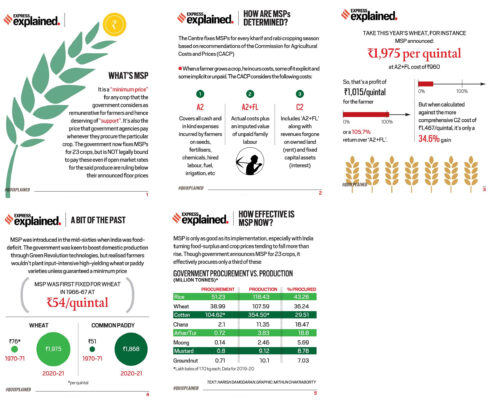- Home
- Prelims
- Mains
- Current Affairs
- Study Materials
- Test Series
MSP is not the way to increase farmers’ income
After two successive droughts in 2014-15 and 2015-16, the government set out an ambitious target to double farmers’ incomes by 2022-23. The Ashok Dalwai Committee was set up to chalk out a strategy to achieve this target of doubling farmers’ incomes and set the goal to be achieved over seven years with the base year of 2015-16.
It clearly stated that a growth rate of 10.4% per annum would be required to double farmers’ real income by 2022-23. According to an estimate of farmers’ income for 2015-16 by NABARD in 2016-17, the average monthly income of farmers for 2015-16 was Rs 8,931
As per the Situation Assessment Survey (SAS) of agricultural households (for 2018-2019 by NSO), an average agricultural household earned a monthly income of Rs 10,218 in 2018-19. In this context, it is important to evaluate Minimum Support Price (MSP) as a policy option to achieve the target of doubling farmers’ income.
A Minimum Support Price was aimed to

- Assure remunerative and relatively stable price environment for the farmers by inducing them to increase production and thereby augment the availability of food grains.
- Improve economic access to food.
- Evolve a production pattern which is in line with overall needs of the economy
- No MSP For Allied Sector: The scope for augmenting farmers’ incomes is going to be more from allied sectors like rearing animals (including fisheries). It is worth noting that there is no minimum support price (MSP) for products of animal husbandry or fisheries and no procurement by the government.
- It is demand-driven, and much of its marketing takes place outside APMC mandis.
- Inadequate Storage System: Those who believe that farmers’ income can be increased by continuously raising the MSP of grains and government procurement.
- However, the fact that grain stocks with the government are already overflowing and more than double the buffer stocking norms.
- MSPs in Favour of Paddy and Wheat: Skewed MSP dominated system of rice and wheat leads to overproduction of these crops.
- Further, it discourages farmers to grow other crops and horticulture products, which has higher demand and subsequently could lead to increase in farmers income.
- Economically Unsustainable: The economic cost of procured rice comes to about Rs 37/kg and that of wheat is around Rs 27/kg. However, market prices of rice and wheat are much lower than the economic cost incurred by the Food Corporation of India (FCI).
- Due to this, the FCI’s economic burden is touching Rs 3 lakh crore.
- This amount eventually will have to be borne by the Union government and may subsequently lead to divergence of funds from being invested in agriculture infrastructure.
- Market-Driven System in the Non-Farm Sector: Milk and poultry don’t have MSP and pricing is done by the company in consultation with milk federations, not by the government.
- Due to this, milk farmers do not have to go through the mandi system paying high commissions, market fees and cess.
- Further, these cooperatives compete with multinational private companies like Nestle, Hatsun which ultimately benefits in augmenting farmers' income.
- Moreover, private companies also invest in rural infrastructure.
- Due to combined effects of these factors, the milk sector has been growing at a rate two to three times higher than rice, wheat and sugarcane.
- Restriction in Exports: Even after producing surplus grains, every year a huge portion of these grains gets rotten. This is due to the restrictions under WTO norms, that grain stocks with the FCI (being heavily subsidized due to MSP) cannot be exported.
- Loopholes in the Implementation of MSP Scheme: The Shanta Kumar Committee, formed to suggest restructuring of the Food Corporation of India (FCI) in 2015, in its report, had stated that only 6% of the MSP could be received by the farmers, which directly means that 94% of the farmers in the country are deprived from the benefit of the MSP
- Investing More in Agri-allied Sector: Wisdom lies in investing more in animal husbandry (including fisheries) and fruits and vegetables, which are more nutritious.
- The best way to invest is to incentivise the private sector to build efficient value chains based on a cluster approach.
- Strengthening FPO: There is a genuine demand for protection of farmers from ruthless market orientation for Profit.
- Thus, there is a need for strengthening of Farmers Producer Organisations (FPOs), this will increase bargaining power of farmers on one hand and provide a suitable investment climate on the other.
- The awareness among the farmers needs to be increased and the information disseminated at the lowest level so that the knowledge would increase the bargaining power of the farmers.
- Timely Payments to Farmers: The basic source of livelihood for the farmers is farming and the delay in payment has a negative effect.
- The delay in payment needs to be corrected and immediate payment should be ensured. For sustainability of farming prompt payment at remunerative rates should be made.
- Insurig Irrigation: State agri-GDP growth is volatile and depends on the monsoon, this is especially true for states that have a much lower level of irrigation.
- For example, Punjab with almost 99 per cent irrigation cover, will have a much more stable income than say Maharashtra with just 19 per cent irrigation cover.










 Latest News
Latest News
 General Studies
General Studies